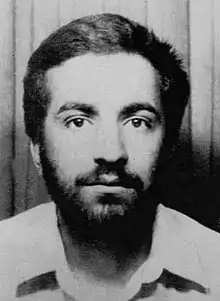Mohammad-Reza Kolahi
Mohammad-Reza Kolahi (Persian: محمدرضا کلاهی) was a member of the People's Mujahedin of Iran (MEK) that, according to Iranian authorities, was suspected of planting a bomb at the headquarters of the Islamic Republican Party (IRP) that killed more than 70 officials in 1981.[4] Kolahi was assassinated in 2015. The Islamic Republic of Iran is believed to have been behind the assassination.[4] He reportedly was a freshman student of electrical engineering who worked as an electrician in the IRP.[2]
Mohammad-Reza Kolahi Samadi | |
|---|---|
 In 1981 | |
| Born | Mohammad-Reza Kolahi Samadi c. 1958/1959 Iran |
| Died | 15 December 2015 (aged 55)[1] |
| Cause of death | Murder |
| Nationality | Iranian |
| Other names | Ali Mo’tamed |
| Alma mater | Iran University of Science and Technology (dropped out)[2] |
| Political party | People's Mujahedin (1979–1981) |
| Military career | |
| Service/ | Revolutionary Committees[3] |
Hafte Tir bombing allegations
On 28 June 1981, two bombs were detonated at the IRP headquarters in Tehran, killing Chief Justice Mohammad Beheshti and some seventy Iranian officials. The Islamic Republic of Iran first blamed SAVAK and the Iraqi regime. Two days later, Ruhollah Khomeini accused the MEK. According to the Islamic Republic of Iran, Kolahi was suspected of planting the bombs as he left the building to "buy ice creams" ten minutes before the detonations.[5] A few years later, a Kermanshah tribunal sentenced to death four "Iraqi agents" for the incident. Another tribunal in Tehran sentenced to death Mehdi Tafari for the same incident. In 1985, the head of military intelligence informed the press that the bombing had been the work of royalist army officers. Iran's security forces blamed the United States and "international mercenaries".[6] According to Ervand Abrahamian, "whatever the truth, the Islamic Republic used the incident to wage war on the Left opposition in general and the Mojahedin in particular."[7]
Assassination
In 2018, it was revealed that Kolahi had been living in the Netherlands as a refugee under the false identity of Ali Motamed (Persian: علی معتمد) and had been murdered in December 2015.[3] Kolahi was married to an Afghan woman and had a 17-year-old son.[3] He had avoided events organised by his Afghan wife’s family for fear of images of his face emerging on social media.[8]
According to Het Parool, two men suspecting of killing Kolahi were identified as 28-year-old Anouar Aoulad-Buochea and 35-year-old Moreo Menso, “Both suspects have a criminal record and come from the same Bijlmer neighborhood of Amsterdam.” Several sources accused the Iranian government of being behind the assassination.[4]
References
- Janene Pieters (27 October 2016), "POLICE: SUSPECTS IN ALMERE ASSASSINATION FROM AMSTERDAM ZUIDOOST", NL Times, retrieved 1 June 2018
- Mousavian, Seyed Hossein; Shahidsaless, Shahir (2014). Iran and the United States: An Insider’s View on the Failed Past and the Road to Peace. Bloomsbury Publishing. ISBN 1628927607.
- "Another Twist In Mysterious Murder Of 1981 Tehran Bombing Suspect", Radio Free Europe/Radio Liberty, 30 May 2018, retrieved 1 June 2018
- "The story behind Iran's 'murder plot' in Denmark", BBC
- James Buchan (2013). Days of God: The Revolution in Iran and Its Consequences. Simon and Schuster. p. 293. ISBN 1416597778.
- "33 HIGH IRANIAN OFFICIALS DIE IN BOMBIMG AT PARTY MEETING; CHIEF JUDGE IS AMONG VICTIMS", NY Times
- Abrahamian, Ervand (1989). Radical Islam: The Iranian Mojahedin. I.B. Tauris. pp. 219–220. ISBN 978-1-85043-077-3.
- Boffey, Daniel. "Death of an electrician: how luck run out for dissident who fled Iran in 1981". the guardian. Retrieved 14 January 2019.
